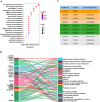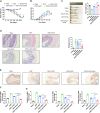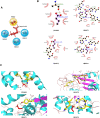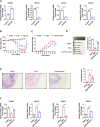The Synergistic Effects of 5-Aminosalicylic Acid and Vorinostat in the Treatment of Ulcerative Colitis
- PMID: 34093178
- PMCID: PMC8176098
- DOI: 10.3389/fphar.2021.625543
The Synergistic Effects of 5-Aminosalicylic Acid and Vorinostat in the Treatment of Ulcerative Colitis
Abstract
Background: The drug 5-aminosalicylic acid (5-ASA) is the first-line therapy for the treatment of patients with mild-to-moderate ulcerative colitis (UC). However, in some cases, 5-ASA cannot achieve the desired therapeutic effects. Therefore, patients have to undergo therapies that include corticosteroids, monoclonal antibodies or immunosuppressants, which are expensive and may be accompanied by significant side effects. Synergistic drug combinations can achieve greater therapeutic effects than individual drugs while contributing to combating drug resistance and lessening toxic side effects. Thus, in this study, we sought to identify synergistic drugs that can act synergistically with 5-ASA. Methods: We started our study with protein-metabolite analysis based on peroxisome proliferator-activated receptor gamma (PPARG), the therapeutic target of 5-ASA, to identify more additional potential drug targets. Then, we further evaluated the possibility of their synergy with PPARG by integrating Kyoto Encyclopedia of Genes and Genome (KEGG) pathway enrichment analysis, pathway-pathway interaction analysis, and semantic similarity analysis. Finally, we validated the synergistic effects with in vitro and in vivo experiments. Results: The combination of 5-ASA and vorinostat (SAHA) showed lower toxicity and mRNA expression of p65 in human colonic epithelial cell lines (Caco-2 and HCT-116), and more efficiently alleviated the symptoms of dextran sulfate sodium (DSS)-induced colitis than treatment with 5-ASA and SAHA alone. Conclusion: SAHA can exert effective synergistic effects with 5-ASA in the treatment of UC. One possible mechanism of synergism may be synergistic inhibition of the nuclear factor kappa B (NF-kB) signaling pathway. Moreover, the metabolite-butyric acid may be involved.
Keywords: 5-ASA; SAHA; butyric acid; protein-metabolite interactions; synergistic effects; ulcerative colitis.
Copyright © 2021 He, Wen, Zhong, Weng, Jiang, Mi and Liu.
Conflict of interest statement
The authors declare that the research was conducted in the absence of any commercial or financial relationships that could be construed as a potential conflict of interest.
Figures






Similar articles
-
Jianpi Qingchang decoction alleviates ulcerative colitis by inhibiting nuclear factor-κB activation.World J Gastroenterol. 2017 Feb 21;23(7):1180-1188. doi: 10.3748/wjg.v23.i7.1180. World J Gastroenterol. 2017. PMID: 28275298 Free PMC article.
-
Addition of Berberine to 5-Aminosalicylic Acid for Treatment of Dextran Sulfate Sodium-Induced Chronic Colitis in C57BL/6 Mice.PLoS One. 2015 Dec 7;10(12):e0144101. doi: 10.1371/journal.pone.0144101. eCollection 2015. PLoS One. 2015. PMID: 26642326 Free PMC article.
-
Peroxisome proliferator-activated receptor-γ is downregulated in ulcerative colitis and is involved in experimental colitis-associated neoplasia.Oncol Lett. 2015 Sep;10(3):1259-1266. doi: 10.3892/ol.2015.3397. Epub 2015 Jun 19. Oncol Lett. 2015. PMID: 26622660 Free PMC article.
-
5-Aminosalicylic acid, a specific drug for ulcerative colitis.Scand J Gastroenterol. 2015 Aug;50(8):933-41. doi: 10.3109/00365521.2015.1018937. Epub 2015 Mar 2. Scand J Gastroenterol. 2015. PMID: 25733192 Review.
-
[Drug therapy for ulcerative colitis: salazosulfapyridine and 5-ASA].Nihon Rinsho. 2005 May;63(5):820-4. Nihon Rinsho. 2005. PMID: 15881176 Review. Japanese.
Cited by
-
Homoharringtonine Attenuates Dextran Sulfate Sodium-Induced Colitis by Inhibiting NF-κB Signaling.Mediators Inflamm. 2022 Sep 29;2022:3441357. doi: 10.1155/2022/3441357. eCollection 2022. Mediators Inflamm. 2022. PMID: 36211988 Free PMC article.
-
Network Pharmacology and Molecular Docking Analysis on Molecular Mechanism of Qingzi Zhitong Decoction in the Treatment of Ulcerative Colitis.Front Pharmacol. 2022 Feb 8;13:727608. doi: 10.3389/fphar.2022.727608. eCollection 2022. Front Pharmacol. 2022. PMID: 35237152 Free PMC article.
-
Vorinostat (SAHA) and Breast Cancer: An Overview.Cancers (Basel). 2021 Sep 19;13(18):4700. doi: 10.3390/cancers13184700. Cancers (Basel). 2021. PMID: 34572928 Free PMC article. Review.
-
Macrophage-Targeted Berberine-Loaded β-Glucan Nanoparticles Enhance the Treatment of Ulcerative Colitis.Int J Nanomedicine. 2022 Nov 14;17:5303-5314. doi: 10.2147/IJN.S379792. eCollection 2022. Int J Nanomedicine. 2022. PMID: 36406639 Free PMC article.
-
Stigmasterol Restores the Balance of Treg/Th17 Cells by Activating the Butyrate-PPARγ Axis in Colitis.Front Immunol. 2021 Oct 6;12:741934. doi: 10.3389/fimmu.2021.741934. eCollection 2021. Front Immunol. 2021. PMID: 34691046 Free PMC article.
References
LinkOut - more resources
Full Text Sources

